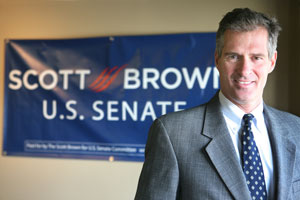
Flickr/<a href="http://www.flickr.com/photos/statesenatorscottbrown/4163375103/">Scott Brown</a> (Publicity photo).
During a press conference on February 4, newly elected Sen. Scott Brown (R-Mass.) claimed, “the last stimulus bill didn’t create one new job.” The fact-checkers at PolitiFact.com say that’s “pants-on-fire” wrong. Here’s what four independent analyses of the stimulus found:
Congressional Budget Office: Between 800,000 jobs (low estimate) and 2.4 million jobs (high estimate) saved or created.
IHS/Global Insight: 1.25 million jobs saved or created.
Macroeconomic Advisers: 1.06 million jobs saved or created.
Moody’s economy.com: 1.59 million jobs saved or created.
And here’s what the Heritage Foundation’s Brian Reidl came up with when the fact-checkers called him to ask about Brown’s claim:
“Every dollar Congress injects into the economy must first be taxed or borrowed out of the economy,” writes economist Brian Riedl of the conservative Heritage Foundation. “No new purchasing power is created; it is merely transferred from one part of the economy to another…. Removing water from one end of a swimming pool and pouring it in the other end will not raise the overall water level—no matter how large the bucket. Similarly, borrowing money from one part of the economy and redistributing to another part of the economy will not create new growth—no matter how big the stimulus bill.”
Matt Yglesias takes Reidl to task:
So suppose this engineer Henry Ford wants to build a car factory, but he doesn’t have the money it costs to build a car factory, so he borrows the money from a coal dealer named Alexander Malcomson—is that a zero-sum transfer that doesn’t create jobs?
The issue with government stimulus spending, I would say, isn’t that money doesn’t “fall from the sky.” The issue is that we’re not very confident that congressional appropriators can allocate real resources (people, electricity, buildings, steel, etc.) in the most efficient way and prefer to leave this allocative function up to the free market…. But if unemployment is at 10 percent, office vacancies are sky-high, retail stores are closing their doors, millions who would prefer full-time work are working part time, and capacity utilization is in the dirt then things look different. It’s hard for government planners to outsmart the market in terms of how resources should be employed, but it’s not that hard—having tons of people sitting around doing nothing is not an efficient outcome.
This stuff should be obvious. But despite near-universal consensus among experts that the stimulus worked, 41 percent of American adults think it had no effect or made things worse. And that’s why if so-called “mainstream” economists want politicians to keep listening to them, they’re going to have to do a better job of explaining their theories to the general public.









